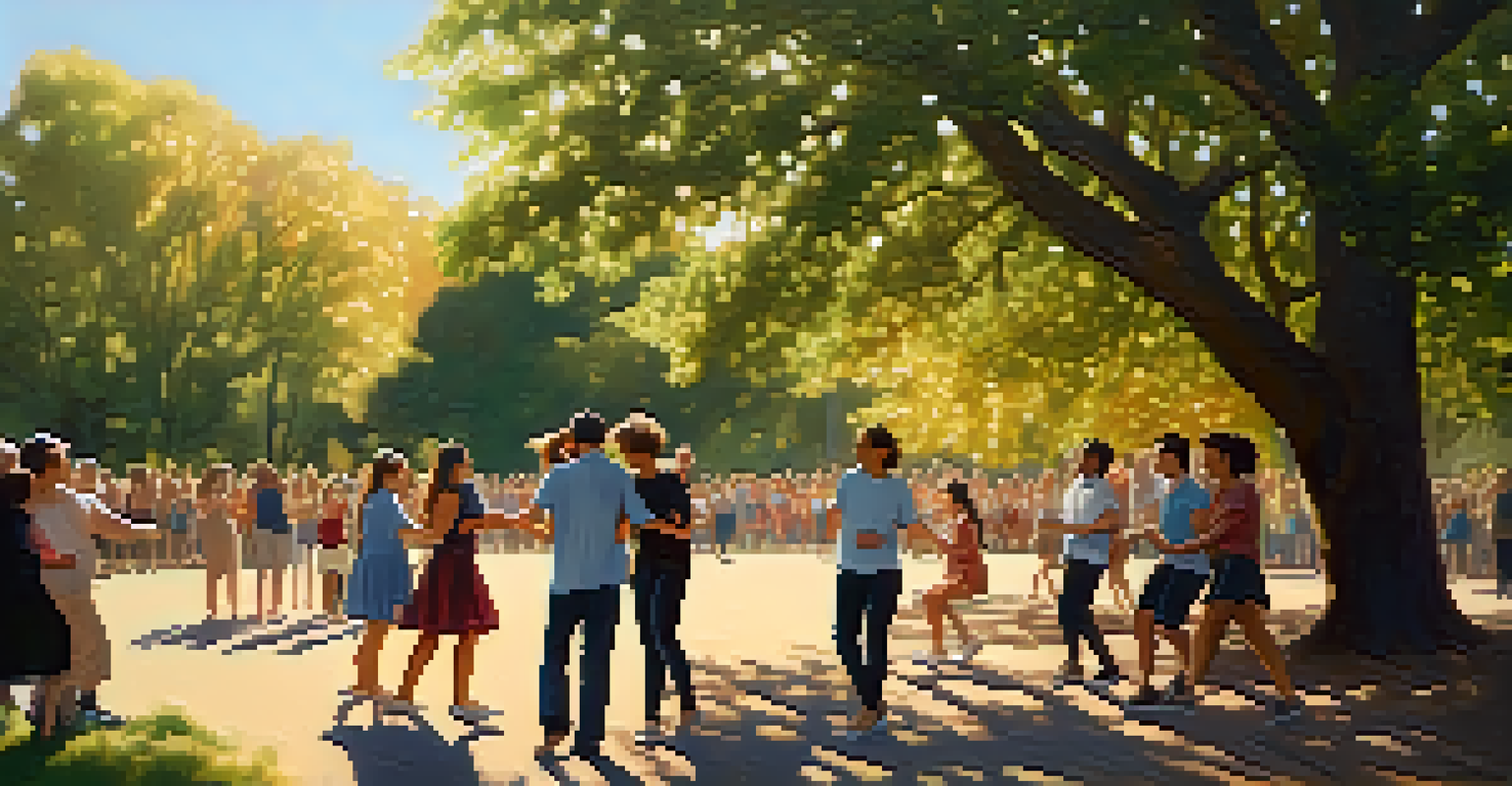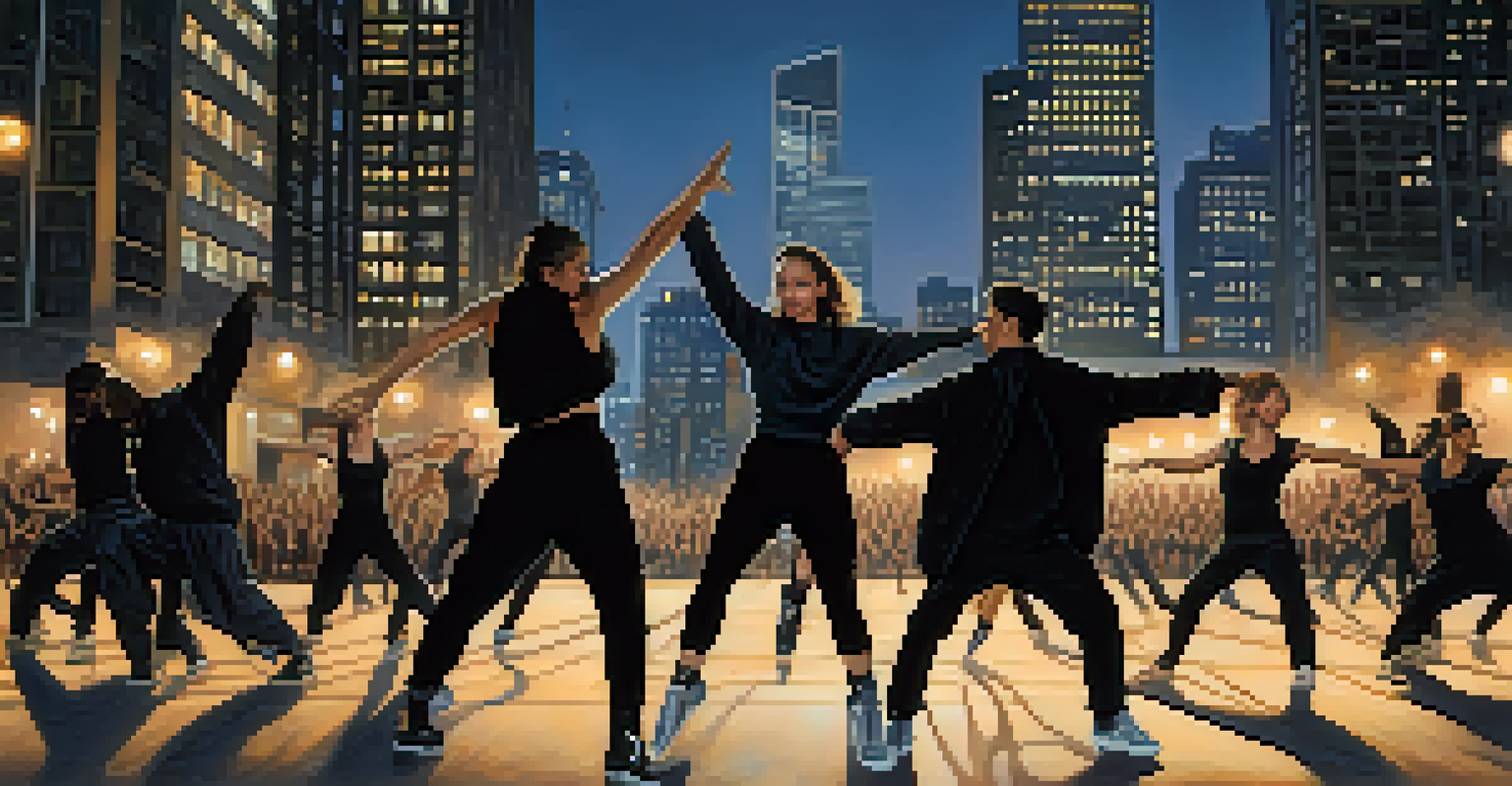The Role of Dance in Social Movements and History

Dance as a Form of Expression in Social Movements
Dance has long served as a powerful form of expression, allowing individuals to communicate emotions and ideas that words alone cannot capture. In social movements, dance becomes a tool for solidarity, helping to unify participants around a common cause. For instance, during the Civil Rights Movement, dances like the Lindy Hop and the Twist were not just recreational; they symbolized resistance and community among activists.
Dance is the hidden language of the soul.
Moreover, dance can convey messages of hope and resilience. When groups come together to dance, they share a collective experience that strengthens their resolve. This communal aspect often fosters a sense of belonging and purpose, making the act of dancing an essential part of the movement's identity.
Through choreographed routines or spontaneous celebrations, dance creates an atmosphere of empowerment. Historical events such as the Stonewall Riots saw the LGBTQ+ community using dance as a means of protest, showcasing their identity and demanding their rights in a vibrant and unforgettable way.
Historical Significance of Dance in Movements
Throughout history, dance has played an essential role in cultural movements, often reflecting the societal changes of the time. From the suffragette marches in the early 20th century to the anti-apartheid protests in South Africa, dance has been woven into the fabric of advocacy, marking significant moments in history. Each of these movements used dance to make statements about freedom, equality, and human rights.

For example, the use of traditional dances by Indigenous peoples during protests highlights their connection to land and culture. This not only raises awareness of their struggles but also educates the wider public about their heritage, fostering respect and understanding.
Dance Unites Movements
Dance fosters solidarity and community among participants, helping to unify individuals around shared causes.
As an art form, dance documents history in ways that written records cannot. The rhythms, movements, and styles evolve with social changes, providing insight into the spirit of the times and the emotions that fuel movements.
The Role of Dance in Building Community
Dance has an incredible ability to bring people together, fostering a sense of community that is vital for social movements. When individuals participate in dance, they often experience a shared connection that transcends language and cultural barriers. This collective experience can help to galvanize support for a cause and encourages more people to get involved.
In every movement, there is a history that tells not just of the past, but of the future we are building.
For instance, community dance events during protests or rallies create spaces where participants can connect on a deeper level. These gatherings often serve as a reminder of the power of unity, reinforcing the idea that together, they can create change. This sense of belonging can inspire individuals to contribute actively to the movement.
Moreover, dance works as a form of healing within communities affected by social injustices. It provides an outlet for expression and helps individuals process their experiences, making it easier to move forward together.
Dance as Protest: From the Streets to the Stage
Dance has also been used as a form of protest, where performers take to the streets or stages to convey powerful messages. This type of protest can attract media attention and raise awareness about social issues, making it an effective tool for advocacy. Choreographers and dancers create pieces that reflect the struggles and aspirations of their communities, turning their bodies into instruments of change.
One notable example is the 'Dancing in the Streets' events that emerged during the Black Lives Matter movement. These events utilized dance to celebrate Black culture while simultaneously protesting systemic racism. The visibility of dance in this context not only highlights the importance of the cause but also draws in diverse audiences.
Cultural Dance Preserves Heritage
Incorporating traditional dances into social movements not only honors cultural identities but also raises awareness of historical struggles.
Through this method, dance transcends traditional boundaries, transforming public spaces into platforms for activism. It energizes movements and provides a vivid visual representation of the collective desire for change.
Cultural Dance and Its Influence on Social Movements
Cultural dance plays a significant role in social movements by preserving and promoting heritage while advocating for social change. Traditional dances often carry historical significance and tell stories that resonate with the struggles of marginalized communities. By incorporating these dances into their movements, activists can educate others about their histories and cultural identities.
For example, the haka, a traditional Maori dance from New Zealand, has been used in various protests to express cultural pride and solidarity. Its powerful movements and chants resonate deeply, making it an effective tool for raising awareness and asserting identity.
Incorporating cultural dance into social movements not only honors those traditions but also strengthens community ties. It serves as a reminder of the resilience and creativity of those fighting for their rights and inspires future generations to carry on the legacy.
Dance as a Means of Documentation and Memory
Dance serves as a form of documentation, capturing the essence of social movements in ways that written records often cannot. The movements, music, and expressions involved in dance create a living history that can be passed down through generations. This embodiment of experiences allows future generations to connect with the past and understand the emotional weight of those struggles.
Documentaries and performances that focus on dance often highlight pivotal moments in history, offering audiences a visceral experience of the events. For example, dance films that showcase the Civil Rights Movement can evoke powerful emotions, making the viewers feel as if they were part of that historical moment.
Dance as a Living History
Dance serves as a unique form of documentation, capturing the essence of social movements and allowing future generations to connect with past struggles.
Through dance, memories are kept alive, allowing the legacies of social movements to endure. This continuity helps to inspire ongoing advocacy, reminding us of the challenges faced and the victories won.
The Future of Dance in Social Movements
Looking ahead, dance will undoubtedly continue to play a vital role in social movements, adapting to the changing landscape of activism. As technology evolves, new platforms for sharing dance—such as social media—allow for broader reach and engagement. Dancers can now create viral movements that galvanize support for various causes, making dance an even more powerful tool for change.
Moreover, the rise of global connectivity means that diverse dance styles can inspire and inform one another, creating a rich tapestry of movements rooted in solidarity. As issues like climate change and social justice gain traction, dance can unify and mobilize people across borders to advocate for shared goals.

Ultimately, as long as there are struggles for justice and equality, dance will remain a dynamic force in social movements, echoing the hopes and dreams of those who dare to dream of a better world.